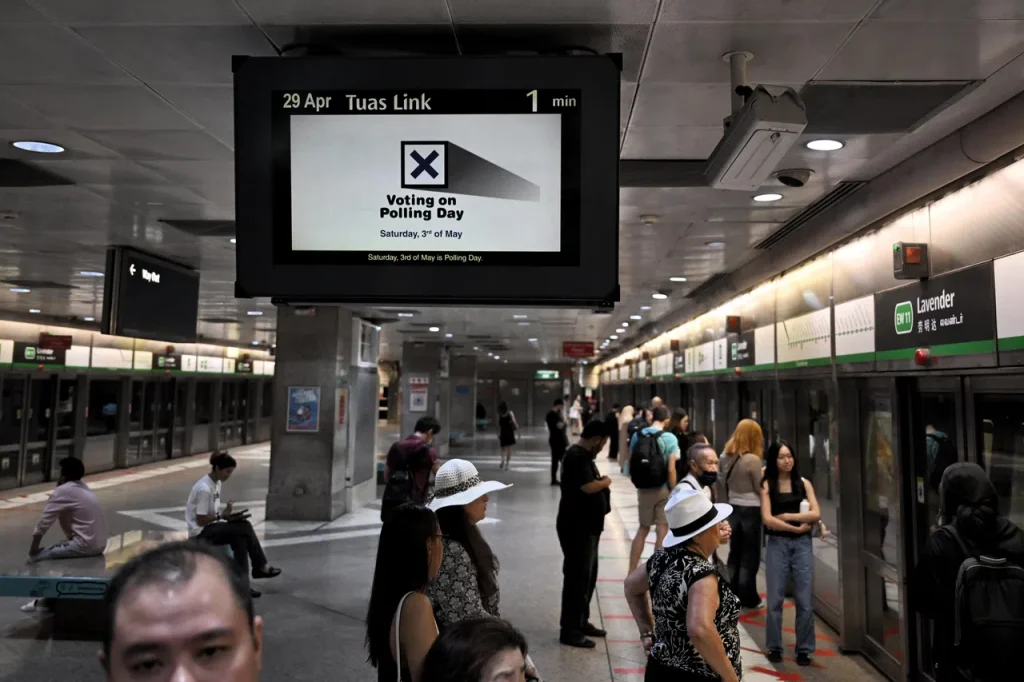[SINGAPORE] After nine days of frantic campaigning, dozens of rally speeches and media interviews, and hundreds of walkabouts covering almost every inch of the island, the day of reckoning is finally here.
On Saturday (May 3), as many as 2.63 million eligible voters will head to the ballot box to pick their preferred Members of Parliament.
This general election (GE) takes place against the backdrop of global economic uncertainty, trade wars, inflation and housing concerns, among other issues.
It is the first GE for Prime Minister Lawrence Wong since he was sworn in last year, and subsequently took over as secretary-general of the ruling People’s Action Party (PAP).
It was 18 days ago, on the afternoon of Apr 15, when PM Wong advised President Tharman Shanmugaratnam to dissolve Parliament and issue the Writ of Election – paving the way for the country’s 14th GE. That quickly sent political parties into overdrive.
The campaign – which was fought on the ground and on the Internet and social media – began on Apr 23 and ended just before midnight on Thursday. Friday marked the start of the mandatory cooling-off period that will only be lifted after the polls close on Saturday at 8 pm.
BT in your inbox

Start and end each day with the latest news stories and analyses delivered straight to your inbox.
A total of 211 candidates – including two independents – have been in the race to fill 97 seats across 33 constituencies in Singapore’s next Parliament.
Five of those seats were confirmed, with the PAP winning the Marine Parade-Braddell Heights GRC via a walkover – the first walkover in any constituency since 2011 – as there were no opponents on Nomination Day. This means that close to 132,000 residents there will not be voting.
For the other 206 people still in the running, they spent each day of the campaign – often from the crack of dawn until late into the night – meeting residents, handing out flyers, taking wefies and speaking at rallies.
The PAP is the only party that has fielded candidates for all 97 seats. The largest opposition party, the Workers’ Party (WP), has fielded 26 candidates. The Progress Singapore Party, the only other party with a presence in the previous term of Parliament, has fielded 13 candidates.
The polling stations will stay open for 12 hours, from 8 am to 8 pm. On Thursday, the Elections Department (ELD) issued an advisory to say that voters can check their polling station’s queue status by scanning the QR code on their poll card before heading out.
They need to bring either the physical or electronic poll card, as well as approved documents of identity such as their NRIC or passport. The voter turnout for the election in 2020 was 95.81 per cent.
Some of the 18,389 eligible Singaporean voters living abroad were able to do their duty before Polling Day. At the Singapore High Commission in London, for instance, voting began on Friday at 8 am (3 pm, Singapore time).
There are 10 overseas polling stations for this GE. These are located at the Singapore government’s high commissions, embassies or consulates in Beijing, Canberra, Dubai, Hong Kong, London, New York, San Francisco, Shanghai, Tokyo and Washington.
A little over half of the registered overseas voters were eligible to cast their ballots by post.
Once voting has ended and the local ballots have been tallied, all eyes will be on Civil Aviation Authority of Singapore (CAAS) director-general Han Kok Juan, the GE’s Returning Officer. He will announce the total votes cast for the candidates and declare the winners for each of the constituencies.
But before the official scores are out, the ELD will first reveal the “sample-count” results for each of the 18 Group Representation Constituencies (GRCs) and 15 single-seat wards.
These sample scores have been tallied during several past elections and were first made public at GE2015. They are meant to prevent unnecessary speculation and reliance on unofficial sources of information before all the votes are accounted for, and the final results are out.
Sample counts have a 95 per cent chance of being within four percentage points of the actual count. At the start of the counting process, a hundred ballot papers from each polling station will be randomly chosen by a counting assistant in the presence of the candidates and their counting agents.
The votes will be added up and weighted accordingly to account for the difference in the number of votes cast at each polling station. The sample count for each constituency will be shown as a percentage of the valid votes earned by the candidates.
The sample-count results will be published on the ELD’s website. The department has said, however, that the final results could still be different.
There is, of course, the possibility of a recount of votes in some constituencies. A recount will be automatically conducted if the difference in votes between candidates is 2 per cent or less of the total number of valid votes cast. In the past, candidates or their counting agents had to apply for a recount.
The last time a recount was needed was in GE2015, when residents in Aljunied GRC had waited until after 3 am to find out that the WP retained the constituency with 50.95 per cent of the valid votes.
With all the talking done and the hustings complete, all that is left to do is for citizens to head to one of more than 1,200 polling centres and mark that all-important “X” on their ballot papers beside the candidate or group of candidates of their choice.
For more election coverage, visit our GE2025 microsite


